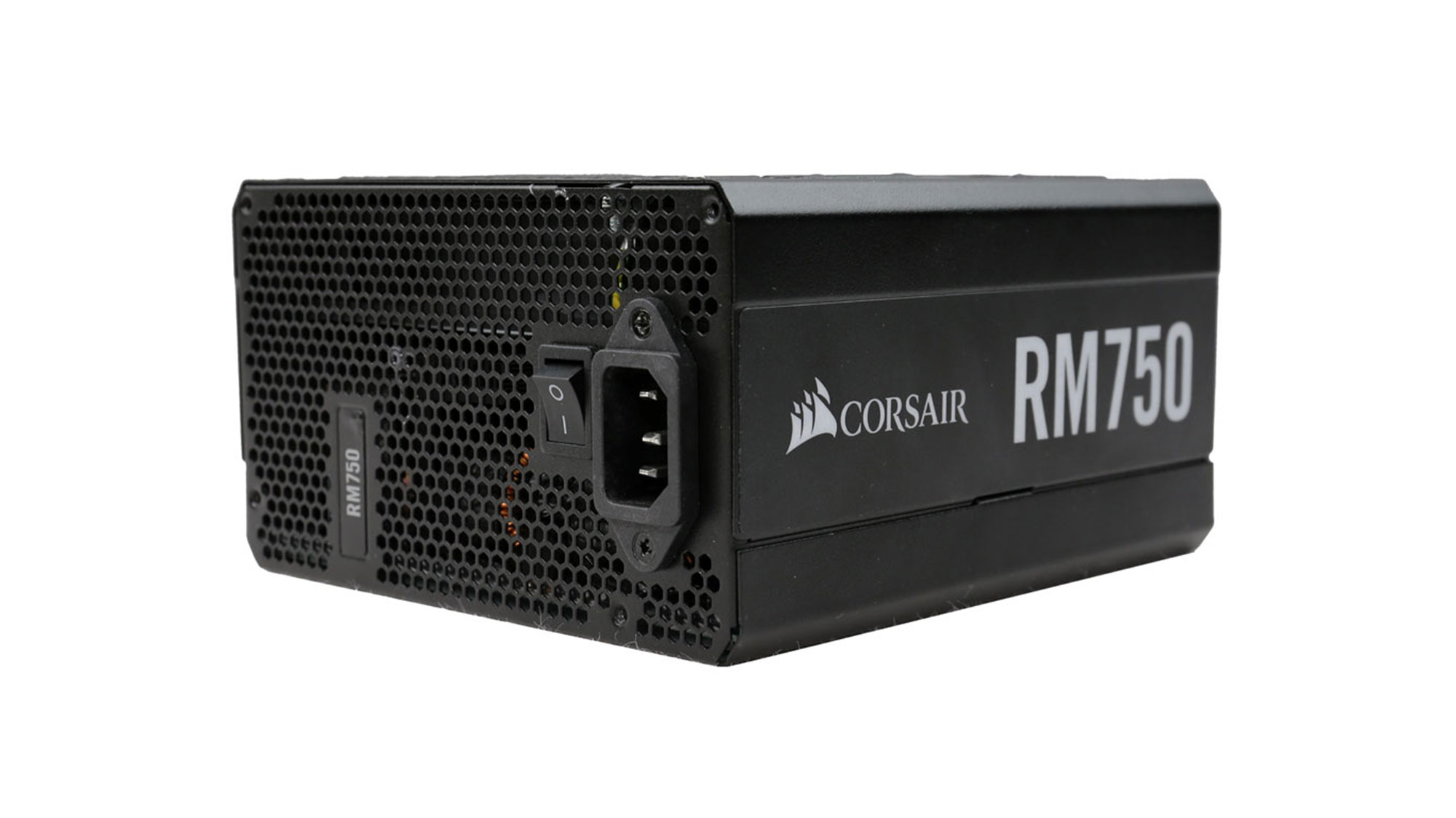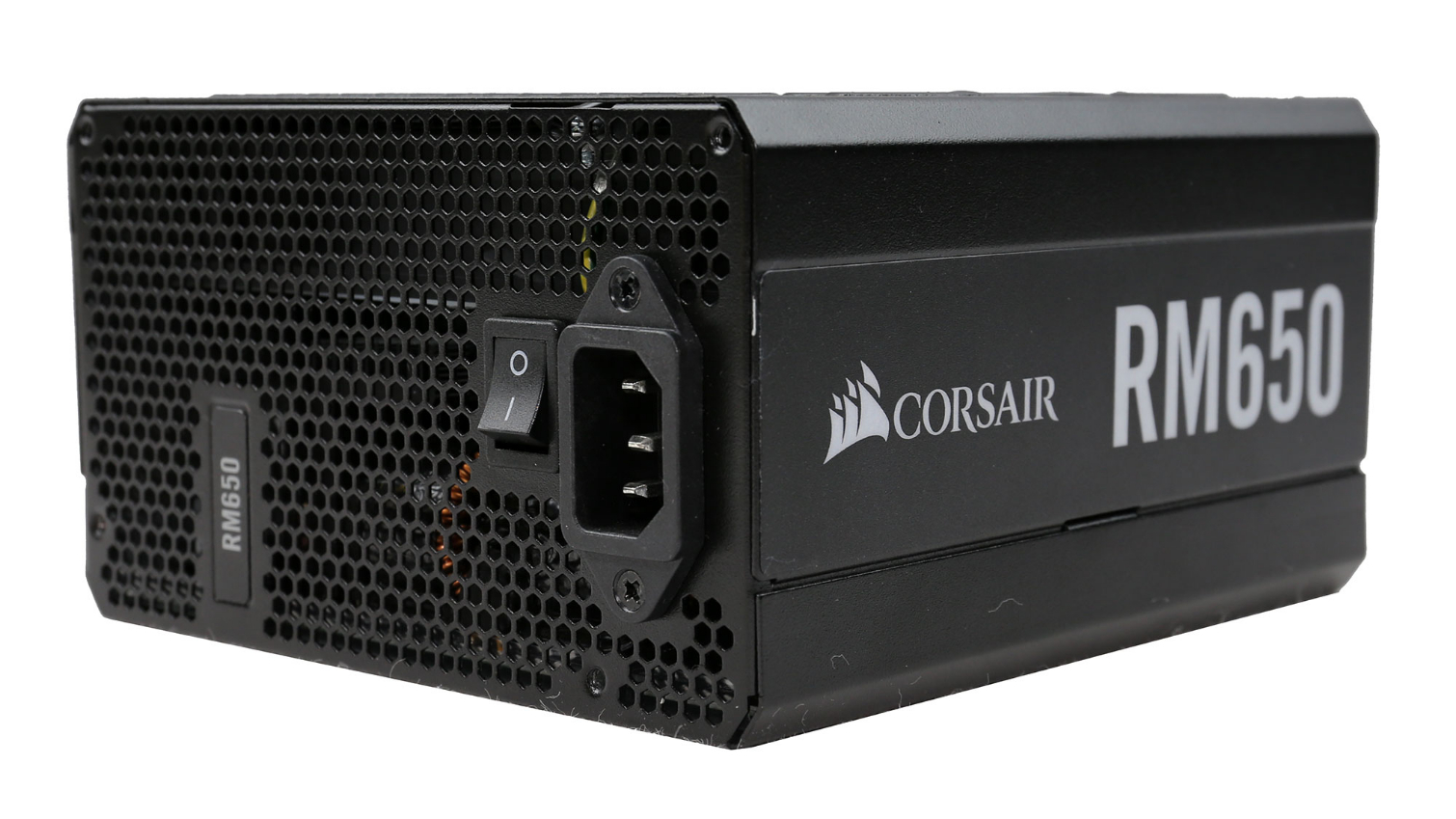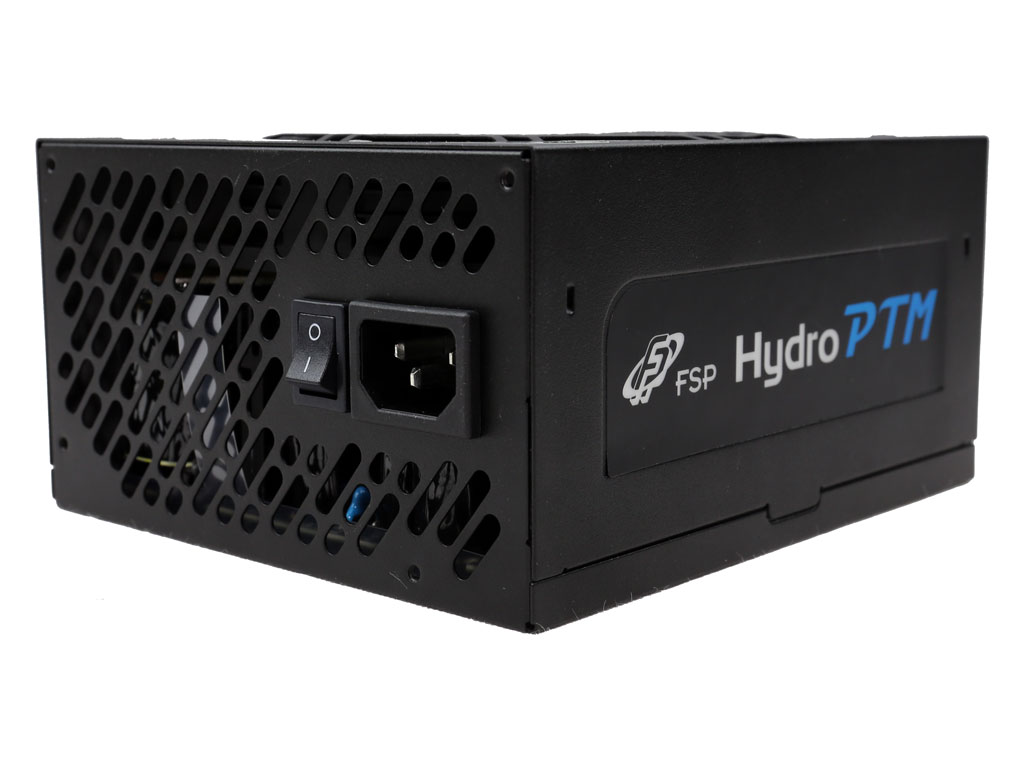Corsair RM650 Power Supply Review: Silent and Efficient
Why you can trust Tom's Hardware
Load Regulation, Hold-Up Time, Inrush Current, Efficiency and Noise
To learn more about our PSU tests and methodology, please check out How We Test Power Supply Units.
Primary Rails And 5VSB Load Regulation
The following charts show the main rails' voltage values recorded between a range of 40W up to the PSU's maximum specified load, along with the deviation (in percent). Tight regulation is an important consideration every time we review a power supply because it facilitates constant voltage levels despite varying loads. Tight load regulation also, among other factors, improves the system’s stability, especially under overclocked conditions and, at the same time, it applies less stress to the DC-DC converters that many system components utilize.
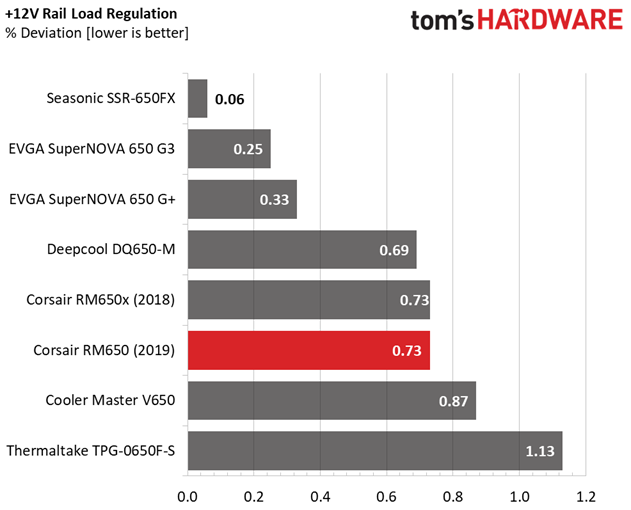
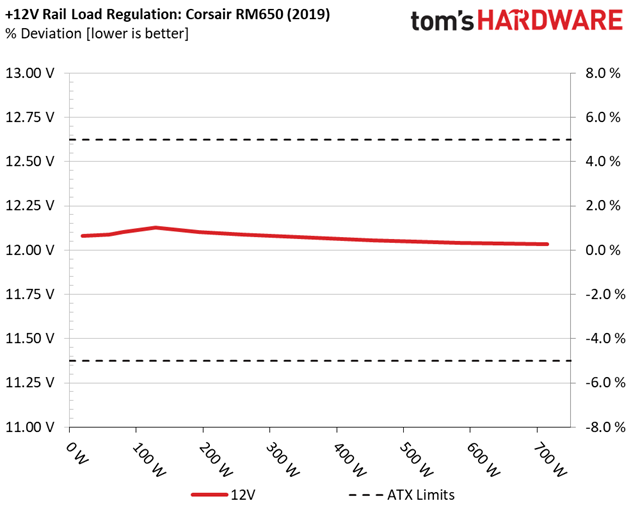
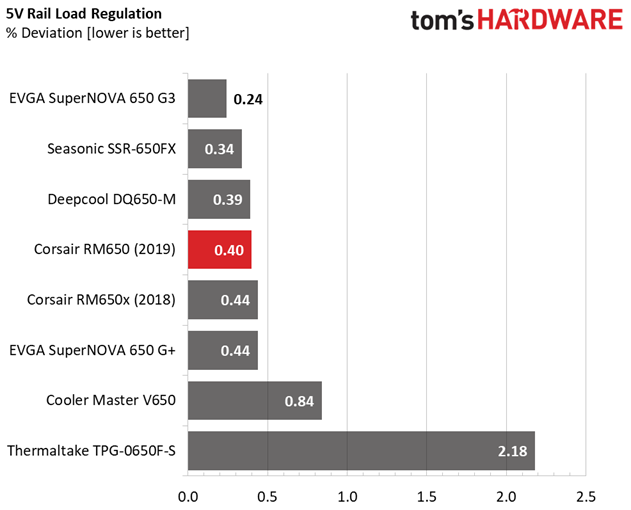
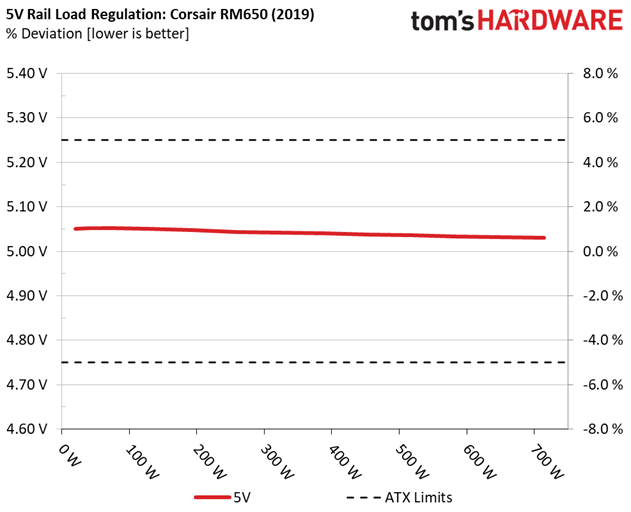
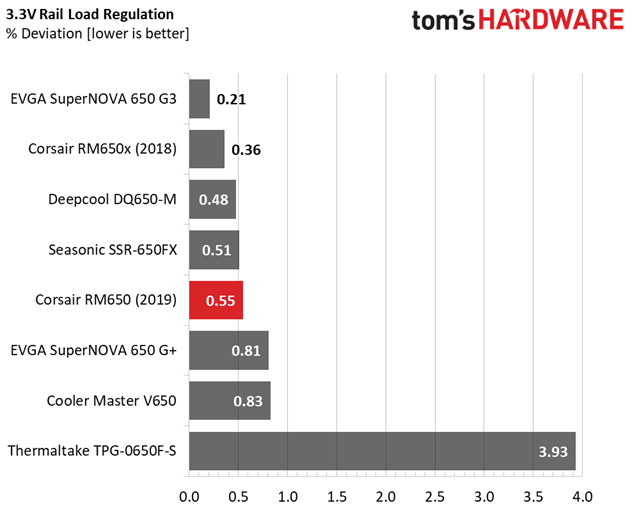
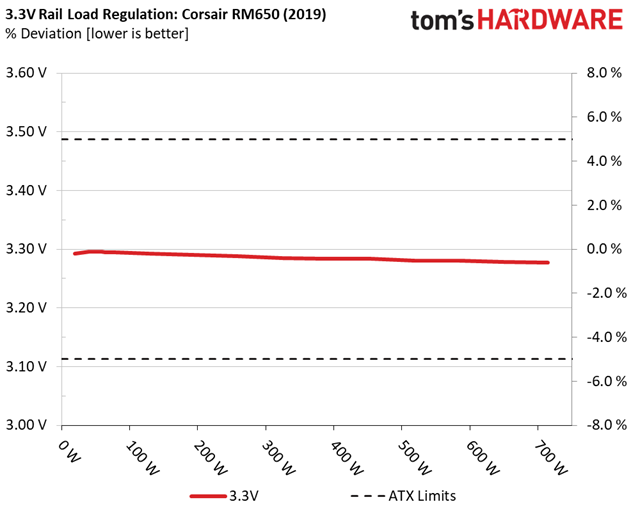
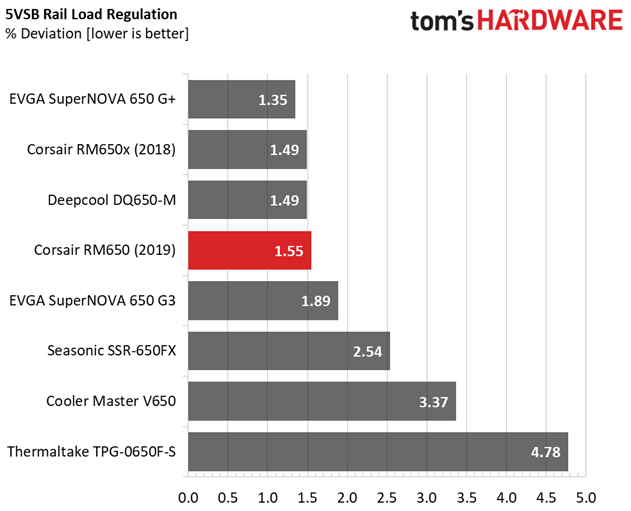
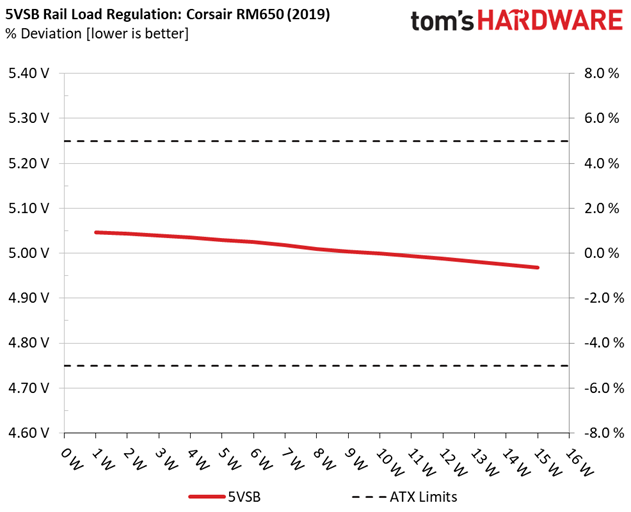
The load regulation is tight, on all rails.
Hold-Up Time
Put simply; hold-up time is the amount of time that the system can continue to run without shutting down or rebooting during a power interruption.
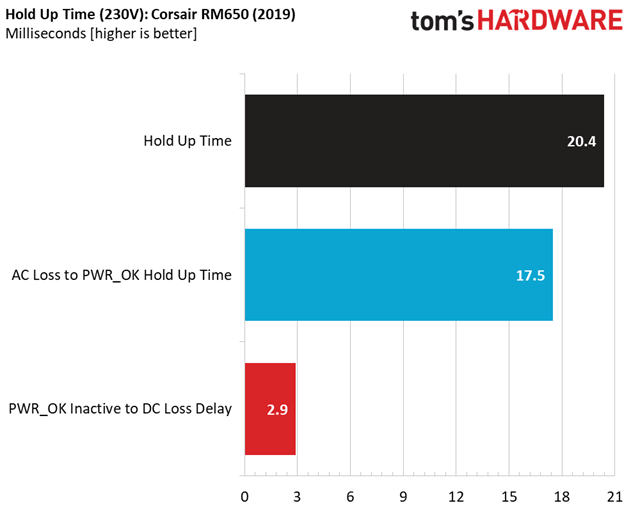
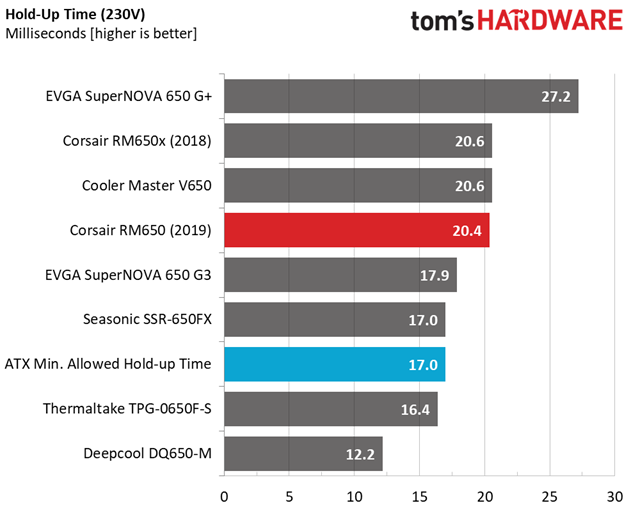
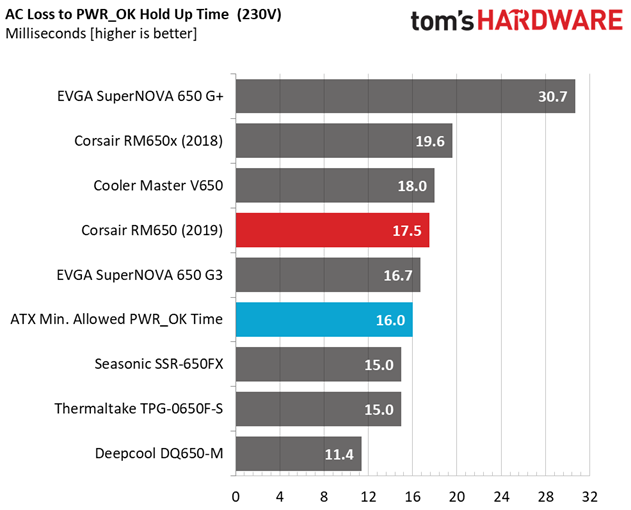
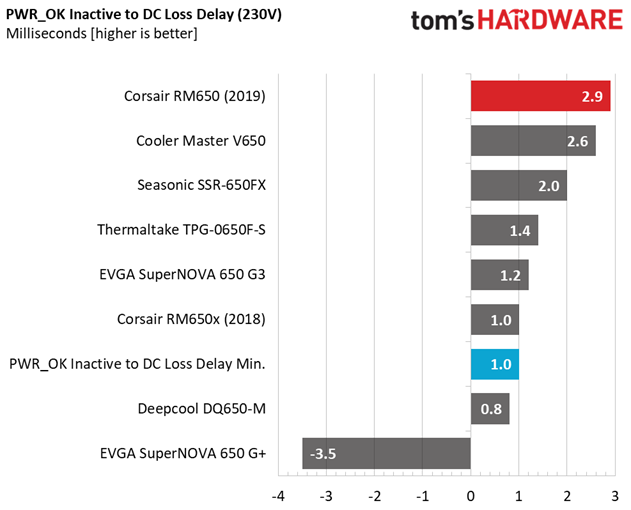
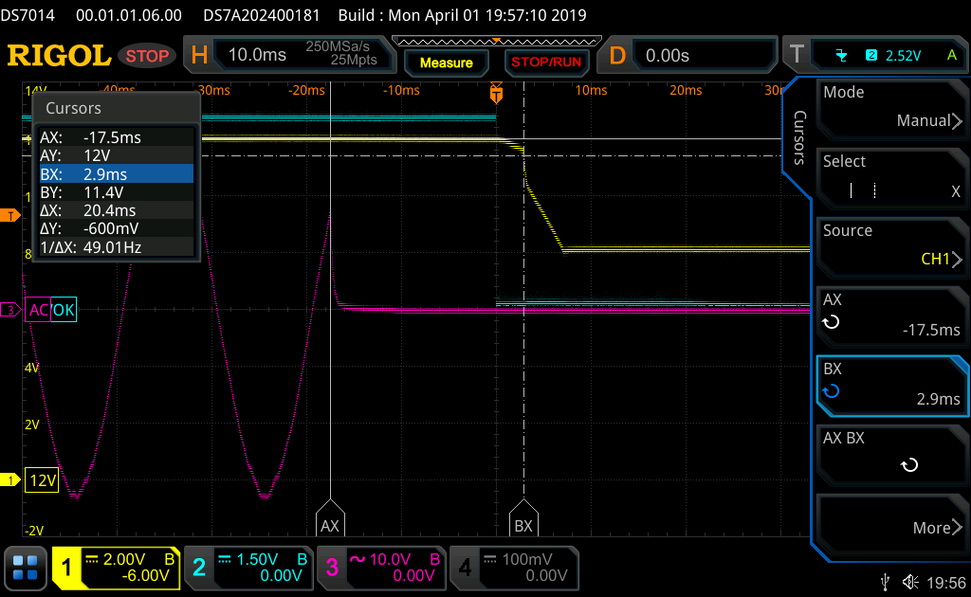
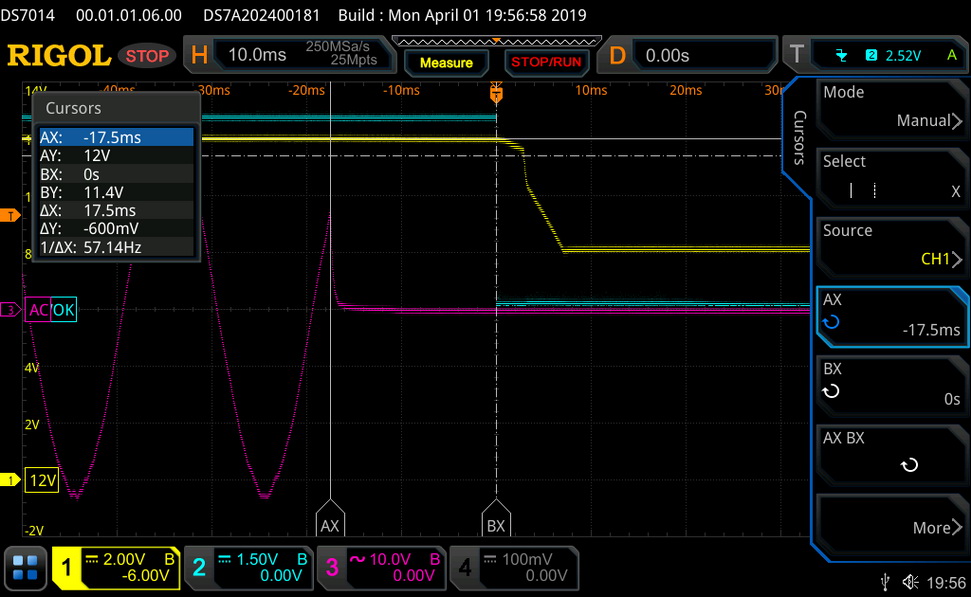
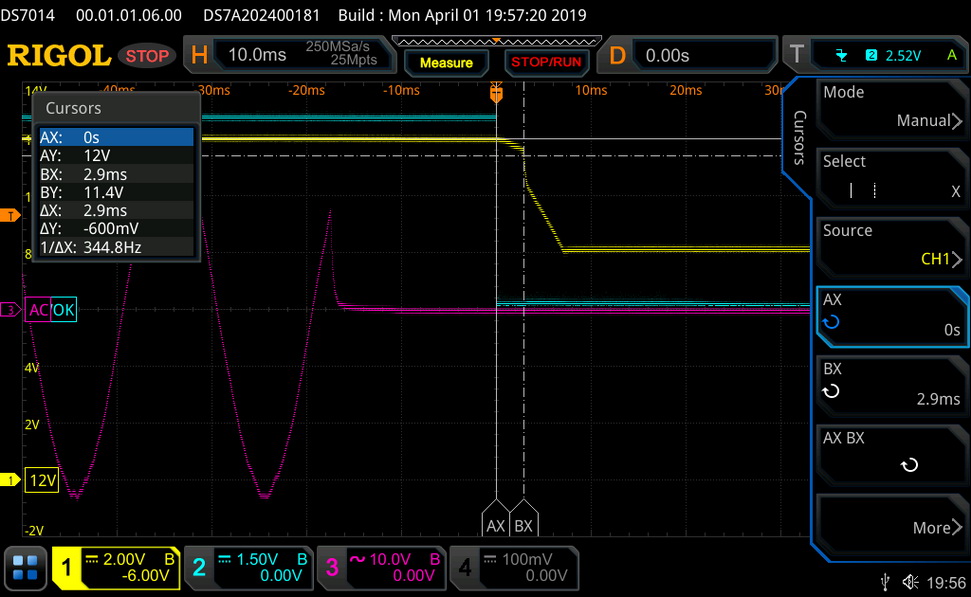
The hold-up time is longer than 17ms, which is what the ATX spec requires, and the power ok signal is accurate.
Inrush Current
Inrush current, or switch-on surge, refers to the maximum, instantaneous input current drawn by an electrical device when it is first turned on. A large enough inrush current can cause circuit breakers and fuses to trip. It can also damage switches, relays, and bridge rectifiers. As a result, the lower the inrush current of a PSU right as it is turned on, the better.

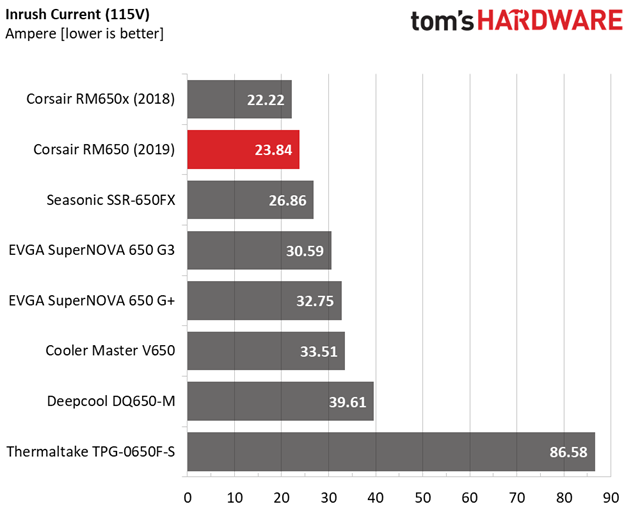
Low inrush currents, with both voltage inputs.
Get Tom's Hardware's best news and in-depth reviews, straight to your inbox.
10-110% Load Tests
These tests reveal the RM650’s load regulation and efficiency levels under high ambient temperatures. They also show how the fan speed profile behaves under increased operating temperatures.
| Test # | 12V | 5V | 3.3V | 5VSB | DC/AC (Watts) | Efficiency | Fan Speed (RPM) | PSU Noise (dB[A]) | Temps (In/Out) | PF/AC Volts |
|---|---|---|---|---|---|---|---|---|---|---|
| 1 | 3.580A | 1.978A | 2.002A | 0.994A | 64.872 | 86.502% | 0 | <6.0 | 43.05°C | 0.970 |
| 12.090V | 5.052V | 3.295V | 5.030V | 74.995 | 39.45°C | 115.12V | ||||
| 2 | 8.118A | 2.970A | 3.007A | 1.194A | 129.339 | 89.823% | 0 | <6.0 | 44.02°C | 0.988 |
| 12.126V | 5.050V | 3.293V | 5.025V | 143.993 | 40.15°C | 115.12V | ||||
| 3 | 13.090A | 3.468A | 3.495A | 1.395A | 194.446 | 91.487% | 0 | <6.0 | 45.01°C | 0.992 |
| 12.104V | 5.048V | 3.290V | 5.018V | 212.539 | 40.83°C | 115.12V | ||||
| 4 | 18.073A | 3.965A | 4.012A | 1.597A | 259.659 | 91.412% | 788 | 16.2 | 41.49°C | 0.994 |
| 12.088V | 5.044V | 3.288V | 5.010V | 284.052 | 46.21°C | 115.11V | ||||
| 5 | 22.724A | 4.958A | 5.022A | 1.799A | 324.935 | 91.137% | 789 | 16.3 | 42.30°C | 0.995 |
| 12.077V | 5.042V | 3.285V | 5.004V | 356.534 | 47.62°C | 115.10V | ||||
| 6 | 27.320A | 5.953A | 6.028A | 2.001A | 389.445 | 90.702% | 790 | 16.3 | 42.63°C | 0.994 |
| 12.066V | 5.040V | 3.284V | 4.999V | 429.366 | 48.98°C | 115.10V | ||||
| 7 | 31.988A | 6.948A | 7.036A | 2.203A | 454.759 | 90.109% | 791 | 16.3 | 43.49°C | 0.994 |
| 12.056V | 5.038V | 3.284V | 4.994V | 504.674 | 50.59°C | 115.10V | ||||
| 8 | 36.658A | 7.944A | 8.044A | 2.406A | 520.055 | 89.421% | 990 | 24.0 | 43.86°C | 0.995 |
| 12.048V | 5.036V | 3.281V | 4.988V | 581.583 | 51.86°C | 115.10V | ||||
| 9 | 41.727A | 8.443A | 8.535A | 2.407A | 584.977 | 88.778% | 1192 | 30.1 | 44.80°C | 0.995 |
| 12.042V | 5.034V | 3.280V | 4.987V | 658.920 | 53.51°C | 115.10V | ||||
| 10 | 46.532A | 8.945A | 9.058A | 3.020A | 649.813 | 88.038% | 1401 | 34.7 | 45.46°C | 0.996 |
| 12.037V | 5.032V | 3.278V | 4.968V | 738.102 | 55.15°C | 115.09V | ||||
| 11 | 51.933A | 8.947A | 9.065A | 3.021A | 714.621 | 87.334% | 1597 | 38.5 | 46.55°C | 0.996 |
| 12.033V | 5.030V | 3.277V | 4.966V | 818.266 | 57.36°C | 115.09V | ||||
| CL1 | 0.138A | 16.004A | 15.999A | 0.000A | 134.825 | 84.188% | 822 | 17.5 | 42.64°C | 0.989 |
| 12.119V | 5.036V | 3.285V | 5.077V | 160.148 | 47.98°C | 115.11V | ||||
| CL2 | 54.006A | 1.001A | 0.999A | 1.000A | 663.825 | 88.597% | 1364 | 33.9 | 45.64°C | 0.996 |
| 12.045V | 5.035V | 3.278V | 5.007V | 749.267 | 55.47°C | 115.09V |
The unit's passive operation lasts up to the third test, with close to 41°C ambient. We have to increase the load at 110% and crank up the heat inside the hot box, at higher than 46°C, to force the fan to operate at its full speed.
20-80W Load Tests
In the following tests, we measure the RM650's efficiency at loads significantly lower than 10% of its maximum capacity (the lowest load the 80 PLUS standard measures). This is important for representing when a PC is idle with power-saving features turned on.
| Test # | 12V | 5V | 3.3V | 5VSB | DC/AC (Watts) | Efficiency | Fan Speed (RPM) | PSU Noise (dB[A]) | PF/AC Volts |
|---|---|---|---|---|---|---|---|---|---|
| 1 | 1.196A | 0.495A | 0.486A | 0.198A | 19.548 | 79.850% | 0 | <6.0 | 0.836 |
| 12.082V | 5.050V | 3.292V | 5.046V | 24.481 | 115.12V | ||||
| 2 | 2.455A | 0.989A | 1.000A | 0.397A | 39.958 | 84.472% | 0 | <6.0 | 0.939 |
| 12.083V | 5.052V | 3.296V | 5.043V | 47.303 | 115.12V | ||||
| 3 | 3.645A | 1.484A | 1.485A | 0.596A | 59.460 | 86.345% | 0 | <6.0 | 0.966 |
| 12.089V | 5.052V | 3.296V | 5.039V | 68.863 | 115.12V | ||||
| 4 | 4.895A | 1.980A | 2.000A | 0.795A | 79.841 | 87.433% | 0 | <6.0 | 0.977 |
| 12.103V | 5.052V | 3.295V | 5.035V | 91.317 | 115.12V |
The efficiency levels under light loads are extremely high.
Efficiency
Next, we plotted a chart showing the RM650’s efficiency at low loads, and loads from 10 to 110% of its maximum-rated capacity. The higher a PSU’s efficiency, the less energy goes wasted, leading to a reduced carbon footprint, besides lower electricity bills.
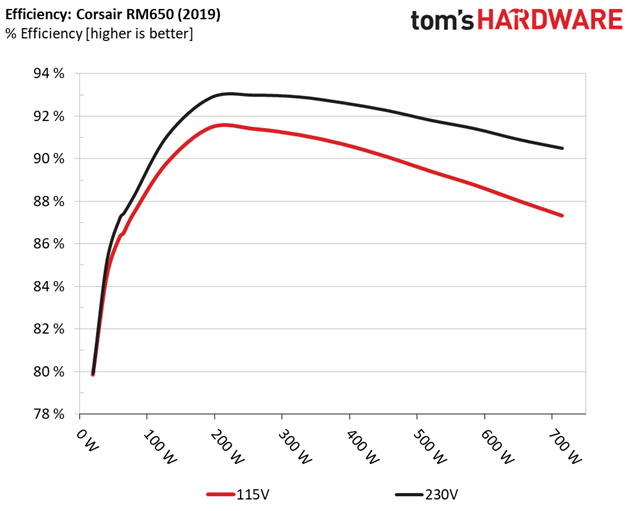
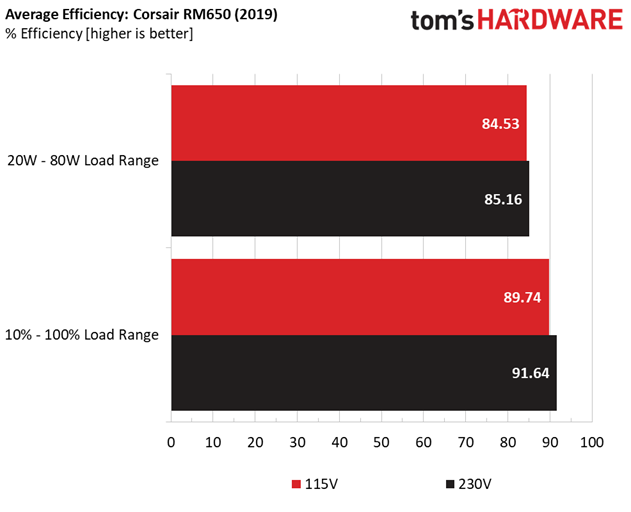
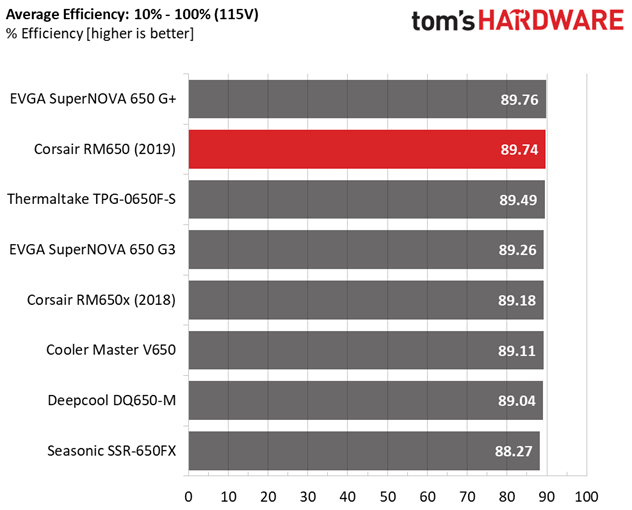
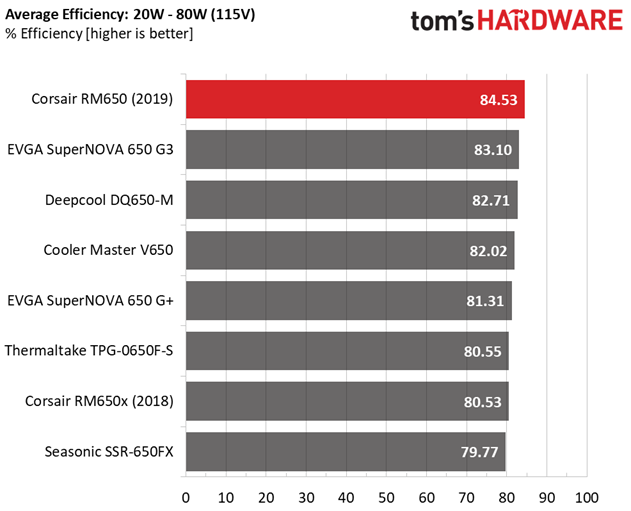
The RM650 is efficient under both light and normal loads.
5VSB Efficiency
| Test # | 5VSB | DC/AC (Watts) | Efficiency | PF/AC Volts |
|---|---|---|---|---|
| 1 | 0.100A | 0.505 | 75.826% | 0.065 |
| 5.055V | 0.666 | 115.07V | ||
| 2 | 0.250A | 1.263 | 78.011% | 0.145 |
| 5.051V | 1.619 | 115.07V | ||
| 3 | 0.550A | 2.774 | 78.762% | 0.256 |
| 5.044V | 3.522 | 115.07V | ||
| 4 | 1.000A | 5.032 | 77.955% | 0.344 |
| 5.032V | 6.455 | 115.07V | ||
| 5 | 1.500A | 7.529 | 77.771% | 0.393 |
| 5.019V | 9.681 | 115.08V | ||
| 6 | 3.000A | 14.943 | 77.109% | 0.456 |
| 4.982V | 19.379 | 115.08V |
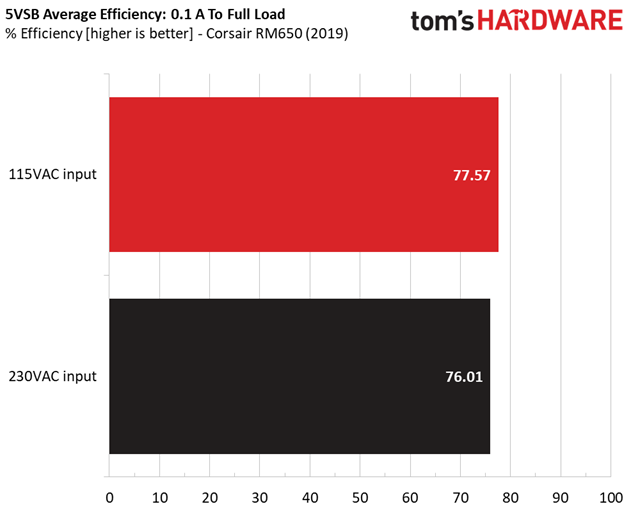
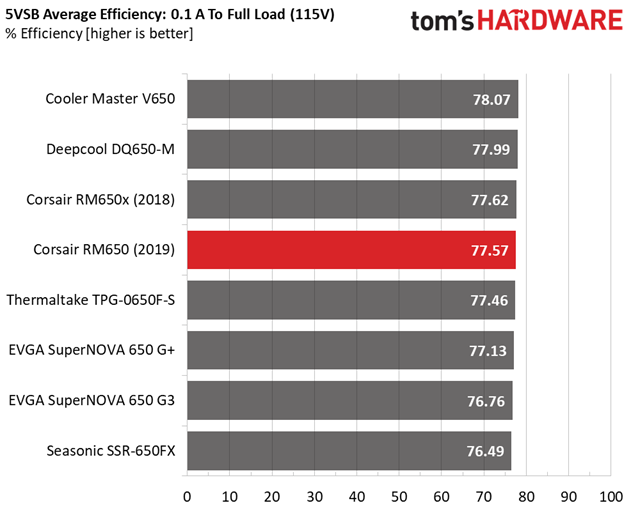
The 5VSB rail is strong and efficient enough to meet the competition.
Power Consumption In Idle And Standby
| Mode | 12V | 5V | 3.3V | 5VSB | Watts | PF/AC Volts |
|---|---|---|---|---|---|---|
| Idle | 12.067V | 5.047V | 3.293V | 5.045V | 0.611 | 0.099 |
| 115.1V | ||||||
| Standby | 0.036 | 0.004 | ||||
| 115.1V |
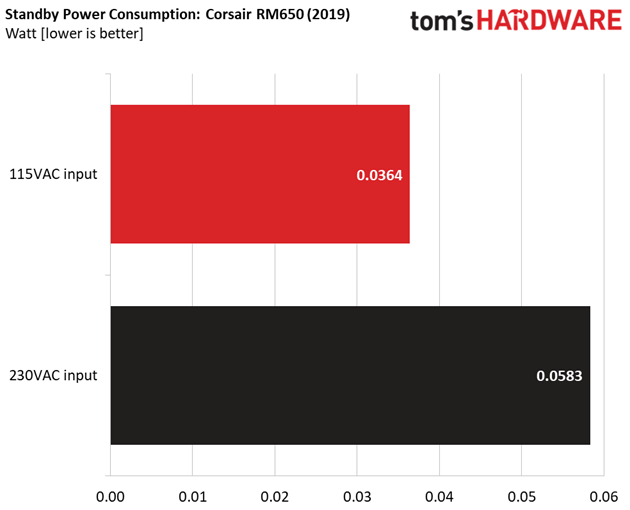
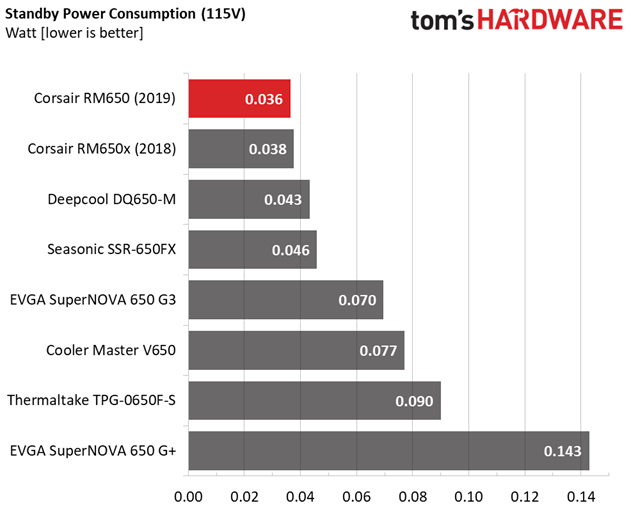
Fan RPM, Delta Temperature, And Output Noise
All results are obtained between an ambient temperature of 37 to 47 degrees Celsius (98.6 to 116.6 degrees Fahrenheit).
The fan profile is relaxed and the semi-passive operation offers minimized noise output at loads up to around 200W, even at high ambient temperatures. As you will see in the graph below, the fan's passive operation won't last long only if you apply high loads on the minor rails.
The following results were obtained at 30 to 32 degrees Celsius (86 to 89.6 degrees Fahrenheit) ambient temperature.
We are used to seeing ultra short semi-passive operation periods at CWT platforms, under high loads on the minor rails. Apparently the DC-DC converters that generate the 5V and 3.3V rails heavily rely on airflow, because they lack the necessary heat sinks.
MORE: Best Power Supplies
MORE: How We Test Power Supplies
MORE: All Power Supply Content
Current page: Load Regulation, Hold-Up Time, Inrush Current, Efficiency and Noise
Prev Page Specifications and Part Analysis Next Page Protection Features, DC Power Sequencing, Cross-Load Tests and Infrared Images
Aris Mpitziopoulos is a contributing editor at Tom's Hardware, covering PSUs.
-
jonnyguru Some background:Reply
The new Intel specification requires better efficiency at 2%-10% load and new timings (T1 and T3 to support modern standby mode). This was not easy/cheap to achieve, so Corsair couldn't just replace the current RMx in the market with a new, more expensive version without tangible differences. So the capacitors and fan was "down graded" (though Hong Hua is a fantastic fan manufacturer) to allow this "new version" of the RM to meet an acceptable price point.
Fun fact: Removing the caps from the cables saved A LOT of money. As you can see, it didn't have much impact. The caps in the cables in other models are only there to appease reviewers (like Aris) that compare ripple from one model to the next within mV of each other. -
Aris_Mp Replyjonnyguru said:Some background:
The new Intel specification requires better efficiency at 2%-10% load and new timings (T1 and T3 to support modern standby mode). This was not easy/cheap to achieve, so Corsair couldn't just replace the current RMx in the market with a new, more expensive version without tangible differences. So the capacitors and fan was "down graded" (though Hong Hua is a fantastic fan manufacturer) to allow this "new version" of the RM to meet an acceptable price point.
Fun fact: Removing the caps from the cables saved A LOT of money. As you can see, it didn't have much impact. The caps in the cables in other models are only there to appease reviewers (like Aris) that compare ripple from one model to the next within mV of each other.
Thank you Jon for the explanation on why the price had to drop so little compared to the RMx. Every time there is an ATX change, the production cost goes higher :(
the in-cable caps provide the wow factor he he. -
refillable ReplyAris_Mp said:Thank you Jon for the explanation on why the price had to drop so little compared to the RMx.
Wait, saw this review earlier but I realized that it has Su'scon caps. Su'scon is the "avoid" tier in your own capacitor tier list. Red flag? Makes me think that this series is even more useless than I previously thought especially that the RM650X can be bought for so cheap these days. -
jonnyguru Replyrefillable said:Wait, saw this review earlier but I realized that it has Su'scon caps. Su'scon is the "avoid" tier in your own capacitor tier list. Red flag? Makes me think that this series is even more useless than I previously thought especially that the RM650X can be bought for so cheap these days.
Aris has yet to visit a capacitor factory. -
refillable Reply
I don't get it, but I pretended I do :LOL:jonnyguru said:Aris has yet to visit a capacitor factory. -
jonnyguru Replyrefillable said:I don't get it, but I pretended I do :LOL:
Since moving from being a reviewer to someone working in the industry, I've learned that 75% of what is said in reviews, including a lot of the stuff I have said in reviews, is total B.S. -
refillable Replyjonnyguru said:Since moving from being a reviewer to someone working in the industry, I've learned that 75% of what is said in reviews, including a lot of the stuff I have said in reviews, is total B.S.
Thanks for clearing that up.
